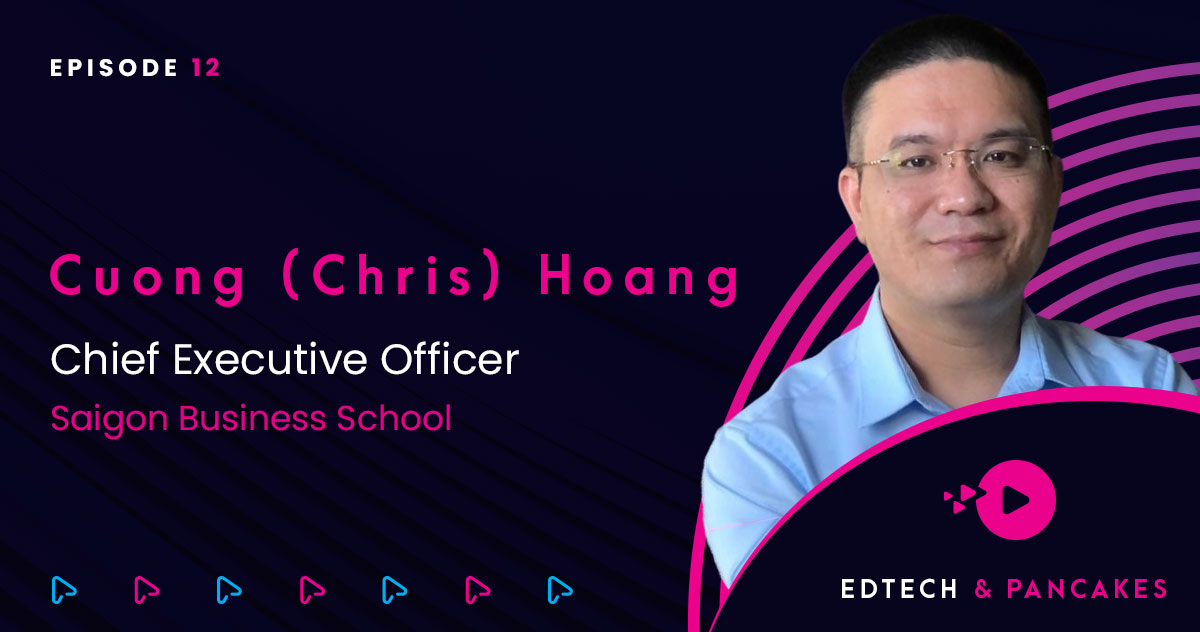Vietnam’s role in international education is evolving rapidly. Once a significant source of outbound students, the country is now attracting a growing number of international learners, positioning itself as a key study destination in Southeast Asia.
This transformation is fueled by Vietnam’s strong economic growth, increased foreign investment, and the strategic development of its higher education infrastructure. Notably, while historical UNESCO data positioned Vietnam as the third-largest source of internationally mobile students, recent reports indicate a shift, with Uzbekistan now occupying that position.
At the forefront of this evolving landscape is Saigon Business School (SBS). To understand the strategies driving this change, and to provide actionable insights for other institutions, we spoke with Chris Hoang, CEO of SBS, on our EdTech & Pancakes podcast. We discussed effective international student recruitment strategies, examined the challenges of digital transformation, and explored how SBS leverages DreamApply to optimize its admissions process.
Watch the full episode of EdTech & Pancakes
Listen to the audio version of the EdTech & Pancakes on DreamApply’s website, Spotify (listen on the go) or iTunes.
10 key takeaways on international student recruitment in Southeast Asia
Without a centralized admissions system, universities can’t scale international recruitment
Most universities in Southeast Asia still rely on outdated manual admissions processes. For institutions aiming to attract and process thousands of applications efficiently, this is a major roadblock.
“At the moment, we have a network of 43 different agents in different countries. If we manage them manually, it’s still okay, but we cannot grow sustainably. We cannot grow fast if we don’t have a good system behind it” says Cuong Hoang.
DreamApply addresses this challenge by providing a centralized “Dream Panel” where institutions can manage all existing systems, check comments and messages from clients, and control add-ons, allowing for sustainable growth. This contrasts with manual systems that hinder scaling. Learn more about DreamApply’s features here.
Relying solely on education agents is outdated – here’s what works now
For years, Southeast Asian universities have depended on education agents to recruit international students. While agents remain valuable, institutions that rely solely on them risk inefficiencies, missed opportunities, and lack of direct engagement with students.
“Previously, if we wanted to recruit international students, we relied heavily on partnerships with education agents. But nowadays, it’s more important to build a good system, especially with technology support,” says Chris.
DreamApply enhances agent relationships by offering transparent application tracking, data analytics and automations, reducing the reliance on manual processes. For example, institutions can grant advisors varying levels of access, from managing applications to basic details, and generate self-service codes for agents, streamlining their work.
Automation won’t replace people, but it can eliminate busywork
The misconception that automation replaces people prevents many institutions from digitizing their admissions. In reality, automation frees up teams to focus on what truly matters: guiding students, providing personalized support, and making strategic decisions.
“With DreamApply, I don’t have to increase the headcount for my admissions team, but we can still process at least 40 to 50% more applications,” says Chris.
DreamApply streamlines repetitive tasks by automating reminders, follow-ups, and document collection. This is achieved through features like task templates with customizable statuses and automated rules, freeing up staff to focus on high-value interactions with students.
International recruitment success starts with internal readiness
Many universities rush to increase international applications without preparing their teams and infrastructure. Without proper support, student experience suffers.
“The biggest mistake is focusing only on numbers, without preparing faculty, staff, or the necessary infrastructure to support international students,” Chris warns.
DreamApply provides data export capabilities, allowing institutions to utilize applicant information beyond admissions. This can support data transfer to student management systems, inform program development, and enable academic staff participation in evaluations. DreamApply’s data-driven tools empower universities to build a more integrated and prepared international student experience.
Short-term programs help universities test and improve internationalization
Before fully committing to international student recruitment, universities can test their capacity with short-term programs. These allow institutions to identify gaps and refine their approach before scaling up.
“One of my recommendations for our colleagues is to start with short-term programs. International students can come for an exchange program, staying just for one semester, or for a short-term one-week study tour. You learn from them, and your team learns how to take care of them. Then, from a week, you increase to a month, a semester, and full-degree programs,” says Chris.
DreamApply supports flexible admissions workflows, making it easy for universities to manage applications for short-term, exchange, and full-degree programs in one system. For instance, institutions can define terms and intakes, including different deadlines for candidates from different regions, all within DreamApply.
The secret to converting applicants? Timely, well-placed nudges
Attracting applicants is just the beginning, getting them to complete their applications is the real challenge. Many universities lose potential students simply because they fail to follow up at the right moment.
“After a student attends a webinar, gets a scholarship offer, or receives a conditional letter, there’s a golden moment to engage them. But if we don’t follow up, we lose them. Sometimes, we go back later, send a simple reminder, and suddenly, they accept the offer,” Chris explains.
DreamApply automates personalized reminders based on applicant activity, ensuring that universities can engage students at the right time, with the right message – boosting completion rates without adding extra manual work. This is made possible by the system’s automation capabilities, including rules that trigger actions based on conditions.
A positive pre-arrival process reduces drop-offs and strengthens enrollment
Attracting international students is just the first step, ensuring they have a smooth transition before arrival is what truly secures their commitment. Many universities overlook the importance of structured onboarding, but without proper pre-arrival support, students may hesitate, delay, or even withdraw their applications.
“When we recruit international students, the challenge isn’t just about getting them to apply. It’s about ensuring they feel supported from the moment they accept an offer. If the onboarding experience isn’t smooth—if they struggle with visas, accommodation, or orientation—they might reconsider their decision,” says Chris.
DreamApply addresses these challenges by streamlining scholarship and visa applications through a centralized platform. Students receive clear, step-by-step guidance and can track their application status in real-time, reducing anxiety and confusion. Furthermore, the platform allows for the integration of housing applications, enabling students to conveniently browse and secure accommodations alongside their academic enrollment, ensuring a smoother transition and reducing potential drop-offs. Explore this article to learn more about how to prevent applicant drop-offs.
Digital transformation is inevitable: universities that delay it will fall behind
Many institutions hesitate to digitize their admissions due to fear of change or resistance from staff. However, delaying digital transformation comes at a cost – manual processes slow down admissions, reduce efficiency, and make it harder to compete for international students.
“Some universities are too conservative, thinking their manual or local systems are good enough. But they have to think about the future. What works today might not work tomorrow,” says Chris.
DreamApply helps universities future-proof their admissions by providing a scalable, adaptable, and centralized solution that integrates with existing workflows. For example, the system allows for defining institution discovery options like randomized lists and grids, and customization of the system’s look and feel, ensuring a modern and adaptable approach.
Attracting the right students is more important than just increasing numbers
Many universities make the mistake of chasing high application numbers without considering whether the students they attract are the right fit. A strong admissions strategy focuses not just on quantity but also on ensuring that students align with the institution’s programs and values.
“The biggest mistake is following numbers without thinking about faculty capacity, student services, or infrastructure. If you don’t build the right system, you can’t deliver the right experience,” Chris explains.
DreamApply helps universities target and enroll the right students by integrating marketing tools, data analytics, and personalized applicant engagement. For example, institutions can utilize entry points and UTM parameters to track traffic sources and measure campaign effectiveness, ensuring a data-driven approach to recruitment.
Universities that lead in international recruitment prioritize the entire student journey
The most successful universities in international recruitment don’t just focus on increasing application numbers—they optimize every step of the admissions process to ensure students complete their journey from inquiry to enrollment.
“When we use DreamApply, students and agents see we are at the same level as top universities worldwide. It gives them confidence in our institution,” says Chris.
This trust is crucial—not just for attracting applicants, but for ensuring they follow through. DreamApply enables institutions to personalize the admissions process, reduce application drop-off, streamline scholarship management, and optimize tuition fee collection. For instance, the system facilitates the creation of letterheads with dynamic content markers and offers features for managing grants and scholarships, enhancing the overall student experience.
About DreamApply
Founded in 2011 in Estonia, DreamApply is an innovation-driven EdTech organization that improves access to education around the globe. DreamApply’s application management software helps more than 300 educational institutions across 40 countries improve admissions, marketing, financial and other internal processes.
DreamApply’s easy-to-use and customizable software increases student enrollment by 30% and reduces application processing time by 40%. With features designed with and for educational institutions, and integrations with commonly used systems, DreamApply empowers teams to get more done with less effort.
Fill out this form to receive a personalized strategy designed to maximize your student recruitment efforts.
Book a live demo with an expert to explore how DreamApply can support your institution’s unique goals.

